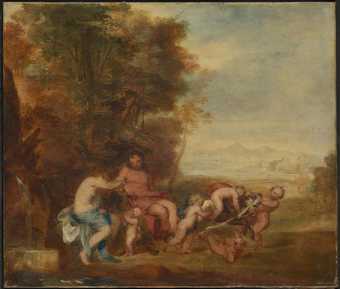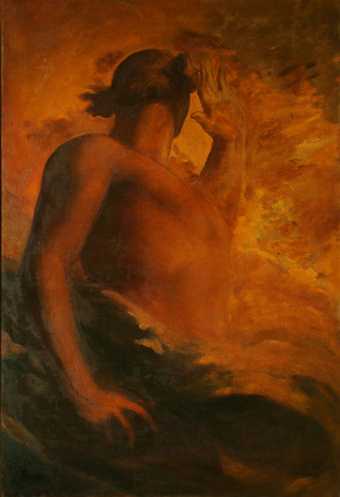Hope 1886 is undoubtedly the most influential, striking, memorable and strange of all George Frederic Watts’s paintings. This sad musician has struck a chord with audiences and critics from the first time it was exhibited at the fashionable Grosvenor Gallery in 1886. The following year at the epic Royal Jubilee exhibition in Manchester it was placed in the middle of an entire wall of his work, taking its place as the symbolic and artistic centre of his achievement. Since then, reproductions have spread Hope around the world. During his lifetime, Watts received letters testifying to its emotional impact on those who saw it. Even today, I know one woman who carries a reproduction in her wallet, and a man who can quote a poem he wrote about it in his youth.
So what makes this such a compelling work? Watts certainly didn’t know. He claimed that the idea came to him quickly and easily. Other works were pondered over and reworked for years before being exhibited, but none had the same impact. His attempts to follow up Hope with Faith and Charity – the other two ‘theological virtues’– were far less well received.
Perhaps the answer lies in the fact that it is not, in essence, a traditionally Christian image. This hunched, isolated, blindfolded and barefoot woman seems, despite the title, to be on the edge of despair. This is not the ‘sure and certain hope’ of Christian tradition. It is more like the hope implied by the expression ‘hoping against hope’. It is the hope of those who refuse to submit to despair when it beckons.
This is probably why the painting seemed so persuasive to Watts’s Victorian contemporaries. As the art historian Malcolm Warner has pointed out, in an age beset by religious doubts, the work appeared to visualise Tennyson’s dubious expression of faith from In Memoriam: ‘To faintly trust the larger hope.’ The trust expressed by the figure is certainly faint. Only one string on her crude wooden lyre remains unbroken. It is her only hope of music, but seems as likely to snap as to sound. In other words, she remains entranced by beauty even when it seems so tenuous.
This preoccupation with music and beauty is unsurprising in a painting exhibited at the Grosvenor Gallery, which was strongly associated with the Aesthetic movement. In many ways Hope is as much concerned with pictorial harmony as a painting by Whistler or Albert Moore – a Nocturne in blue and silver perhaps. Despite its traditional use of allegory, however, it is much more humanly engaging than anything by these artists. The stooping woman is both vulnerable and serene. Clearly many Victorian viewers experienced a fellow-feeling with the character, recognising the vulnerability and aspiring to the serenity. Nor were these the genteel and cultured visitors to the Grosvenor. They were far less elevated individuals, whose own hopes and fears were much more immediate than theological doubt. Watts received a letter from a poor man who had been ‘down on his luck’, but who told the artist he was cheered and encouraged by a reproduction of the painting, which brought him back from the brink of despair. It was said that a prostitute, who felt that ‘life had become unbearable’, saw a photograph of Hope in a shop window. She bought it with ‘her few saved coppers’ and gazed at it until ‘the message sank into her soul, and she fought her way back to a life of purity and honour’.
This may seem a rather sentimental tale of moral redemption. Yet it is exactly the effect that Watts sought to achieve. While Whistler sneered at the vulgar masses who could never appreciate art, Watts had always aspired to find a universal language through which to convey his message to as many people as possible. His efforts can sometimes appear patronising, but his sincerity is difficult to dispute. His earliest works were fairly conventional patriotic narrative paintings destined for the Houses of Parliament, but his aspirations towards public art were later manifested in the more diffuse project of the House of Life, intended as a kind of modern Sistine Chapel in which a series of symbolic images would express the spiritual progress of humanity. Hope was one of many designs envisaged for this great public display. Needless to say, it was never realised. Instead, Watts showed work at the Royal Academy and the Grosvenor, but also loaned paintings to the free Whitechapel Art Gallery run by his friends the Reverend Samuel and Henrietta Barnett.
The Barnetts were devoted to the cause of moral improvement through art, and were firm believers in the qualities of Watts’s works. Their East End parishioners were not always quite so willing to be ‘improved’ by paintings, but the couple insisted that Hope did communicate to the often impoverished and oppressed locals. It did so because it made human desolation seem beautiful, noble and morally redeemable. For one acquaintance of the Barnetts, a trade union leader, it justified his struggle to overcome injustice, despite numerous setbacks. The same message was apparently read into the painting almost a century after it was created, when the Egyptian government issued copies of it to its troops, humiliatingly defeated by the Israelis in 1967.
Watts’s humanitarian aestheticism may have reached out into the twentieth century in other, more purely artistic ways. Such a widely reproduced and circulated image would certainly have been known by the young Picasso. The blue, angular body, plucking at a string, seems like the precursor to Picasso’s own Blue Period paintings, such as The Old Guitarist 1903–4, another hunched, helpless musician. Like the subject of Hope, Picasso’s Blue Period characters are all outsiders, half-real, half-symbolic; both wandering performers and timeless human archetypes. They too occupy a mysterious no-man’s-land between pleasure and desolation, hope and despair.
Watts would probably have recognised the connection between the young Picasso’s art and his own. His style was constantly evolving. He painted at least six different versions of the composition, a common practice for him. Watts continued to rework or revise his most successful images, often with the intention of donating versions to public collections. This included the Hope now in the Tate collection, donated in 1897. His last version is little more than a sketch, painted like other late works in pulsating waves of colour that seem to emanate from the figure. The lyre is barely marked, and the string unindicated. By this stage in his career Watts appears to have believed, like the Spiritualist thinkers who influenced the pioneers of abstract art, that painting could express the force of life itself in colour. This spiritual hope is no longer a Tennysonian fragile string, but a pantheistic life force suffusing the image.


